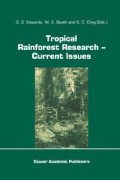Abstract
Many threats to tropical forests and their biodiversity result from social and economic factors. Policies to conserve the forests depend on being able to demonstrate their economic value and on social measures involving local community participation. Research to calculate the total economic value of the forests has involved estimating the direct use value of forest products, the indirect values from environmental benefits and services, and option and existence values. Threats to the forest have endangered the social and economic welfare of many indigenous groups; their survival and the conservation of the forests can often be achieved by reinforcing traditional systems of land tenure and environmental management.
Access this chapter
Tax calculation will be finalised at checkout
Purchases are for personal use only
Preview
Unable to display preview. Download preview PDF.
Literature Cited
CALDECOTT, J. O. 1986. Hunting and Wildlife Management in Malaysia. World Wildlife Fund of Malaysia, Kuala Lumpur.
CRAVEN, L, PURBA, P., SETIONO, D., WOMISWOR, D. & THAMRIN, S. 1992. Community Involvement in Protected Area Establishment and Management in Irian Jaya. Paper presented at IVth World Congress of National Parks and Protected Areas, Caracas.
DIXON, K.A. & SHERMAN, P.B. 1990. Economics of Protected Areas. Earthscan, London.
EATON, P. 1982. Land Tenure and National Parks. Pp. 223–226 in Morauta, L., Pernetta, J. & Heaney, W. (eds). Traditional Conservation in Papua New Guinea. Institute of Applied Social and Economic Research, Port Moresby.
EATON, P. 1985. Land Tenure and Conservation: Protected Areas in the South Pacific. South Pacific Commission, Noumea.
EATON, P. 1986. Grassroots Conservation: Wildlife Management Areas in Papua New Guinea. University of Papua New Guinea, Port Moresby.
FREEMAN, J. Report on the Iban of Sarawak. Government Printing Office, Kuching.
GARE, N. 1986. The Making of a National Park. Parks 11:13–18.
HONG, E. 1987. Natives of Sarawak. Institut Masyarakat, Penang.
HOSE, C. & McDOUGALL, W. 1912. The Pagan Tribes of Borneo. Frank Cass & Co., London.
JACOBSON, S.K. 1991. Resident Attitudes about a National Park in Sabah, Malaysia. Pp.250–262 in West, P.C. & Brechin, S.R. (eds). Resident Peoples and National Parks. University of Arizona Press, Tucson.
KEDIT, P. 1982. An Ecological Study of the Penan. Sarawak Museum Journal XXX, 51:225–279.
LEAMAN, D.J., YUSOF, R. & ARNASON, J.T. 1992. Kenyan Medicinal Plants: Beyond the Inventory. Pp. 456–459 in Ismail, G., Mohamed, M. & Omar, S. (eds). Forest Biology and Conservation in Borneo. Yayasan Sabah, Kota Kinabalu.
LOW, H. 1848. sarawak; its inhabitants and productions. Richard Bentley, London.
McNEELY, J.A. 1988. Economics and Biological Diversity. International Union for the Conservation of Nature and Natural Resources, Gland.
MORAUTA, L., PERNETTA, J. & HEANEY, W. 1982. Traditional Conservation in Papua New Guinea. Institute of Applied Social and Economic Research, Port Moresby.
MUNASINGHE, M. 1992. Biodiversity Protection Policy: Environmental Valuation and Distribution Issues. Ambio 12:3.
PEARCE, D. 1990. An Economic Approach to saving the Tropical Forests. London Environmental Economics Centre, London.
PEARCE, D., MAKANDYA, A. & BARBIER, E.B. 1989. Blueprint for a Green Economy. Earthscan, London.
PEARCE, K., AMAN, V. & JOK, S. 1987. An Ethnobotanical Study of the Iban Community of the Pantu Sub-district, Sri Aman, Division 2, Sarawak. Sarawak Museum Journal XXXVII, 58:223–270.
PETERS, C., GENTRY, A. & MENDELSOHN, R. 1989. Valuation of an Amazonian Rainforest. Nature 339:665–6, 227–236.
REPETTO, R., MAGRATH, W., WELLS, M., BEER, C. & ROSSINI, F. 1989. Wasting assets: natural resources in the national income accounting. World Resources Institute, Washington.
REPETTO, R. & GILLIS, M. 1988. Public Policies and the Misuse of Forest Resources. Cambridge University Press, Cambridge.
RISWAN, R., MAHYAR, U.W., SANGAT-ROEMANTYO, H. & BURLEY, J.S. 1992. Ethnobotany of several medicinal plants in Harowu village, Central Kalimantan. Pp. 441–455 in Ismail, G., Mohamed M. & Omar, S. (eds). Forest Biology and Conservation in Borneo. Yayasan Sabah, Kota Kinabalu.
SAHABAT ALAM MALAYSIA. 1989. The Battle for Sarawak’s Forests. Penang.
SANDIN, B. 1967. The Sea Dayaks of Borneo before the White Rajah Rule. Macmillan, London.
TOBIAS, D. & MENDELSOHN, R. 1991. Valuing Ecotourism in a Tropical Rainforest Reserve. Ambio 20:91–93.
VINCENT, J.R. 1990. Rent Capture and the Feasibility of Tropical Forest Management. Land Economics 66:212–223.
WELLS, M., BRANDON, K. & HANNAH, L. 1990. People and Parks: Linking Protected Area Management with Local Communities. World Bank, Washington.
WESTERN, D. 1984. Amboseli National Park: Human Values and the Conservation of a Savanna Ecosystem. Pp. 93–100 in McNeely, J. & Miller, K. (eds). National Parks: Conservation and Development. Smithsonian Institution, Washington.
WORLD COMMISSION ON ENVIRONMENT AND DEVELOPMENT (WCED). 1987. Our Common Future. Oxford University Press, Oxford.
Author information
Authors and Affiliations
Editor information
Editors and Affiliations
Rights and permissions
Copyright information
© 1996 Kluwer Academic Publishers
About this chapter
Cite this chapter
Eaton, P. (1996). Socio-economic values and tropical rain forest conservation. In: Edwards, D.S., Booth, W.E., Choy, S.C. (eds) Tropical Rainforest Research — Current Issues. Monographiae Biologicae, vol 74. Springer, Dordrecht. https://doi.org/10.1007/978-94-009-1685-2_41
Download citation
DOI: https://doi.org/10.1007/978-94-009-1685-2_41
Publisher Name: Springer, Dordrecht
Print ISBN: 978-94-010-7255-7
Online ISBN: 978-94-009-1685-2
eBook Packages: Springer Book Archive

